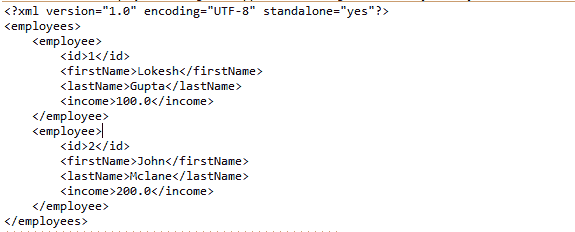原文: https://howtodoinjava.com/jaxb/jaxb-exmaple-marshalling-and-unmarshalling-list-or-set-of-objects/
我们知道 JAXB(用于 XML 绑定的 Java 架构)允许 Java 开发人员将 Java 类映射到 XML 表示形式。 JAXB 提供了两个主要功能:将 Java 对象编组为 XML 的能力和相反的功能,即将 XML 解组为 Java 对象的能力。 JAXB 主要用于实现 Web 服务或任何其他此类客户端接口的应用,在该应用中,数据需要以 XML 格式(而不是 HTML 格式)传输,而对于可视客户端(如 Web 浏览器)来说,HTML 格式是默认格式。
一个很好的例子是 facebook API。 Facebook 已通过 RESTful Web 服务的形式通过一些开放的端点公开了其服务,您在其中单击 URL 并发布了一些参数,而 API 以 xml 格式返回数据。 现在由您决定如何使用这些数据。
在本文中,我以编组和解组对象的集合为例。 Java 中的这些集合可以是:List和Set实现,例如 ArrayList或HashSet。
1)JAXB Maven 依赖关系
要运行 JAXB 示例,我们需要添加运行时 maven 依赖项,如下所示:
<dependency><groupId>com.sun.xml.bind</groupId><artifactId>jaxb-core</artifactId><version>2.2.8-b01</version></dependency><dependency><groupId>com.sun.xml.bind</groupId><artifactId>jaxb-impl</artifactId><version>2.2-promoted-b65</version></dependency>
2)模型类
我创建了一个模型类“Employee”,它具有一些公开字段。 我想构建可以解析一组employees的代码。 请注意,JAXB 在最重要的类上需要 @XmlRootElement 注解,我们将对其进行编组或解组。
ArrayList类是集合框架的一部分,它没有任何 JAXB 注解。 因此,我们需要另外一个类别“Employees”,该类别将代表一组雇员。 现在,在该类中,我们可以添加任何我们喜欢的注解。
@XmlRootElement(name = "employee")@XmlAccessorType (XmlAccessType.FIELD)public class Employee{private Integer id;private String firstName;private String lastName;private double income;//Getters and Setters}
import java.util.List;import javax.xml.bind.annotation.XmlAccessType;import javax.xml.bind.annotation.XmlAccessorType;import javax.xml.bind.annotation.XmlElement;import javax.xml.bind.annotation.XmlRootElement;@XmlRootElement(name = "employees")@XmlAccessorType (XmlAccessType.FIELD)public class Employees{@XmlElement(name = "employee")private List<Employee> employees = null;public List<Employee> getEmployees() {return employees;}public void setEmployees(List<Employee> employees) {this.employees = employees;}}
3)将列表编组为 XML 的示例
编组是“将 Java 对象转换为 xml 表示形式”。 在下面的示例代码中,我首先在控制台中写入employees列表,然后在文件中写入。
//Initialize the employees liststatic Employees employees = new Employees();static{employees.setEmployees(new ArrayList<Employee>());//Create two employeesEmployee emp1 = new Employee();emp1.setId(1);emp1.setFirstName("Lokesh");emp1.setLastName("Gupta");emp1.setIncome(100.0);Employee emp2 = new Employee();emp2.setId(2);emp2.setFirstName("John");emp2.setLastName("Mclane");emp2.setIncome(200.0);//Add the employees in listemployees.getEmployees().add(emp1);employees.getEmployees().add(emp2);}private static void marshalingExample() throws JAXBException{JAXBContext jaxbContext = JAXBContext.newInstance(Employees.class);Marshaller jaxbMarshaller = jaxbContext.createMarshaller();jaxbMarshaller.setProperty(Marshaller.JAXB_FORMATTED_OUTPUT, true);//Marshal the employees list in consolejaxbMarshaller.marshal(employees, System.out);//Marshal the employees list in filejaxbMarshaller.marshal(employees, new File("c:/temp/employees.xml"));}
上面代码的输出是:

JAXB 编组示例输出
4)解组 XML 到列表的示例
解组是将 xml 转换回 Java 对象的过程。 让我们看一下Employees类的示例。
private static void unMarshalingExample() throws JAXBException{JAXBContext jaxbContext = JAXBContext.newInstance(Employees.class);Unmarshaller jaxbUnmarshaller = jaxbContext.createUnmarshaller();//We had written this file in marshalling exampleEmployees emps = (Employees) jaxbUnmarshaller.unmarshal( new File("c:/temp/employees.xml") );for(Employee emp : emps.getEmployees()){System.out.println(emp.getId());System.out.println(emp.getFirstName());}}Output:1Lokesh2John
5. 源代码下载
要下载以上示例的源代码,请点击以下链接。
学习愉快!

